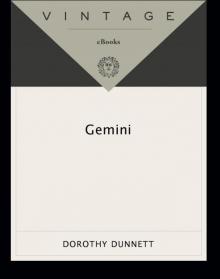 Pawn in Frankincense
Pawn in Frankincense Gemini
Gemini Scales of Gold: The Fourth Book of the House of Niccolo
Scales of Gold: The Fourth Book of the House of Niccolo Moroccan Traffic: Send a Fax to the Kasbah
Moroccan Traffic: Send a Fax to the Kasbah The Ringed Castle: Fifth in the Legendary Lymond Chronicles
The Ringed Castle: Fifth in the Legendary Lymond Chronicles Niccolo Rising
Niccolo Rising Rum Affair: Dolly and the Singing Bird; The Photogenic Soprano
Rum Affair: Dolly and the Singing Bird; The Photogenic Soprano King Hereafter
King Hereafter The Disorderly Knights
The Disorderly Knights The Spring of the Ram: The Second Book of the House of Niccolo
The Spring of the Ram: The Second Book of the House of Niccolo Checkmate
Checkmate Roman Nights: Dolly and the Starry Bird; Murder in Focus
Roman Nights: Dolly and the Starry Bird; Murder in Focus The Unicorn Hunt: The Fifth Book of the House of Niccolo
The Unicorn Hunt: The Fifth Book of the House of Niccolo To Lie With Lions: The Sixth Book of the House of Niccolo
To Lie With Lions: The Sixth Book of the House of Niccolo Split Code: Dolly and the Nanny Bird
Split Code: Dolly and the Nanny Bird Race of Scorpions
Race of Scorpions The Tropical Issue: Dolly and the Bird of Paradise
The Tropical Issue: Dolly and the Bird of Paradise Operation Nassau: Dolly and the Doctor Bird; Match for a Murderer
Operation Nassau: Dolly and the Doctor Bird; Match for a Murderer The Unicorn Hunt
The Unicorn Hunt Roman Nights
Roman Nights Moroccan Traffic
Moroccan Traffic The Spring of the Ram
The Spring of the Ram To Lie with Lions
To Lie with Lions Rum Affair
Rum Affair The Tropical Issue
The Tropical Issue Split Code
Split Code Ibiza Surprise
Ibiza Surprise The Ringed Castle
The Ringed Castle Operation Nassau
Operation Nassau